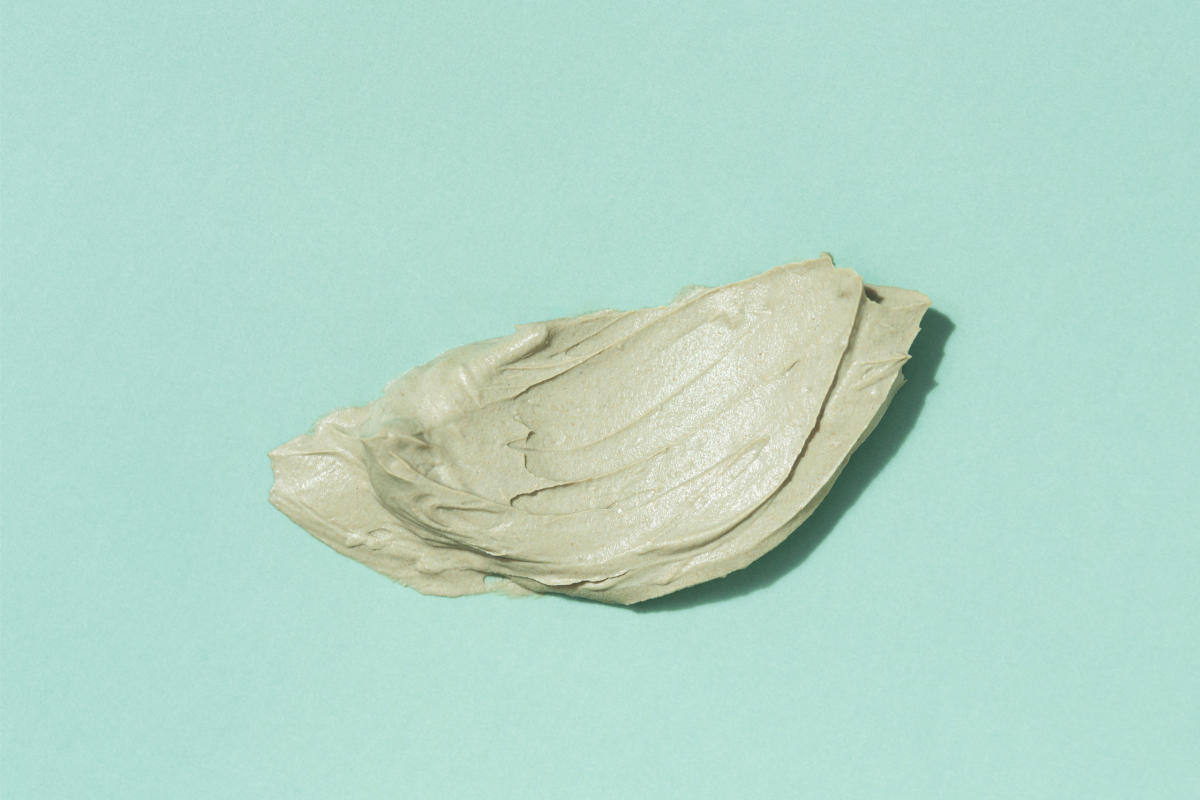Often found close to water, clay is seen as an indicator of its presence in nature. With a history closely linked to water, humans have instinctively appropriated it and integrated it into their lives and cultures. It is one of the oldest materials used by human beings, whether for art, well-being or beauty. It should also be recognised that animals have also learned to take advantage of the benefits of clay. Its virtues have been universally recognised for thousands of years. Our affinity with clay is evolving thanks to scientific studies that have led to an increasingly accurate interpretation of its properties. Modern medicine now focuses on products of natural origin, and gives greater credence to this ancient product.
Its composition
Clay, this multi-faceted sedimentary rock, is distinguished by its many properties beneficial for both beauty and health. Its versatility lies in its wide range of applications, which can be used both internally and externally.
At the heart of clay’s composition is silica, a key element that gives it some of its remarkable qualities. But clay’s mineral diversity doesn’t stop there. It also contains a wealth of essential trace elements and minerals such as magnesium, calcium, aluminium, iron, phosphorus, sodium and potassium, contributing to its broad spectrum of benefits.
Clay is also enriched with other trace elements such as copper, zinc, cobalt, manganese and selenium. These components, although present in smaller quantities, play a crucial role in the healing and regenerative properties of clay. It is fascinating to note that the specific composition of clay can vary according to the geological environment in which it was formed, which explains its diversity in terms of colour and properties.
The colours of clay, ranging from green to red, white, pink and yellow, are mainly due to its iron oxide content. This chromatic variation is not just aesthetic; it also reflects the different concentrations of minerals and offers a clue to the specific properties of each type of clay.
In short, clay is one of nature’s treasures, a concentrate of benefits, whose complex and varied composition is the secret of its remarkable effectiveness in various treatments and care.
The use of clay in external treatments
Since the dawn of time, clay has been used to treat wounds and minor everyday ailments. Clay with a reduced iron content, such as green clay, is effective for treating and healing superficial wounds. Applied to a wound, even an infected one, it will clean it by absorbing impurities such as pus, secretions and bacteria. Its reparative properties will then help the cells to regenerate rapidly.
Spa and thalassotherapy centres use clay as a key treatment. It can be used as a poultice or warm clay mud. This mineral, which is rich in trace elements, mixed with thermal water, helps to alleviate and effectively relieve rheumatic pain. This is mainly due to its anti-inflammatory, analgesic and remineralising properties. Joint pain, osteoarthritis, lumbago, back pain… clay can provide considerable relief. It is also used to reduce aches and fatigue. What’s more, its purifying and detoxifying properties make clay a key element in natural cosmetology.
Can clay be used for hyperhydrosis?
Green clay is often mentioned as a natural remedy for alleviating the symptoms of hyperhidrosis, a condition characterised by excessive, uncontrollable sweating. However, it is important to understand the real effects of green clay on this problem.
Green clay is a natural mineral widely used in alternative medicine and skin care. It is renowned for its absorbing, purifying and soothing properties. Some claim that applying green clay to areas affected by hyperhidrosis can help reduce excessive sweating. The absorbent action of green clay is thought to absorb excess moisture from the skin, which can contribute to a feeling of dryness. In addition, green clay can also help to eliminate toxins and impurities from the skin, which can be beneficial for hyperhidrosis sufferers.
However, it should be noted that the effectiveness of green clay in the treatment of hyperhidrosis has not been scientifically proven. Specific studies on the use of green clay for hyperhidrosis are limited and there is little conclusive evidence that it is actually effective.
It is also important to stress that green clay cannot treat the underlying cause of hyperhidrosis. If you suffer from severe hyperhidrosis, it is advisable to consult a healthcare professional who can suggest more suitable treatments, such as medication, surgery or botulinum toxin injections.
The different clays:
Clays are distinguished by their mineral composition and colour, each offering specific properties suited to various therapeutic and cosmetic needs, from purifying green clay to soothing pink clay.
Green clay:
Green clay, for example, the most popular of all, is the ally of problem skin. Its aluminium, silica and lime content will purify the skin. Argiletz ready-to-use clay can be used as a beauty mask or poultice. It is ideal for combination to oily or acne-prone skin. It absorbs excess sebum and regulates its secretion. While eliminating toxins and impurities, it revitalises the skin and encourages cell renewal.
Red clay:
Red clay, on the other hand, is ideal for treating blotchy skin. Rich in iron oxide, it improves blood circulation and combats irritation. Used as a mask once a week or as a poultice, red clay restores radiance to the face for a guaranteed healthy glow.
White clay:
White clayis better suited to dry, sensitive skin. Like green and red clay , it has a healing action. This allows it to repair delicate, mature or atopic skin. Our hair also benefits from the virtues of clay. Known for its softness, it can be used as a hair mask to purify the hair and restore its vigour. It can also be used to make natural deodorants. Its absorbent properties limit perspiration.
Rose:
Made from a subtle blend ofwhite clay andred clay,pink clay is very rich in trace elements. It is particularly suitable for sensitive and delicate skin. At once purifying, softening and soothing, it can be used as a face and hair mask.
Yellow:
Ideal for mature skin. Its magnesium and manganese content stimulates cell oxygenation and tones the skin.
Using clay internally
Using clay internally, as a cure or dietary supplement, is recognised for its detoxifying and regulating virtues, offering benefits for digestive and general health, always subject to use in accordance with recommendations.
Geophagy: an ancestral practice
Geophagy, the act of ingesting clay, is an instinctive and ancient practice. Historically, clay was used as a natural and effective anti-poison in ancient times and in the Middle Ages. Today, this tradition has more scientific justification. By interacting directly with the digestive mucosa, clay reinforces its protective barrier against alkaloids and toxins.
Clay and gastrointestinal health
In the treatment of gastrointestinal pathologies, clay acts without destroying the intestinal flora, but by restoring it. Its absorbency helps to eliminate gas and leads to the evacuation of toxic substances. Its healing and regenerative properties make it an ally against ulcers.
Antiseptic and bactericidal properties
Clay has antiseptic and bactericidal properties, eliminating intestinal parasites and neutralising excess bacteria. These properties help to reduce inflammation and promote healing of the intestinal mucosa.
Boosting the immune system
Clay therapy expert Dr Jade Allègre highlights the benefits of green clay in reducing inflammation and fighting viruses and bacteria. Green clay also helps to strengthen the immune system by acting on the intestinal microbiota.
The remineralising effect of clay
Clay is also renowned for its remineralising effect on the body. Rich in essential minerals such as iron, calcium, potassium, silica and magnesium, it is recommended for the prevention or treatment of certain deficiencies. Its suspension in water shares similarities with thermal spring water, enriched with minerals from the geological layers.
What are the advantages and disadvantages of clay?
There are a number of advantages and disadvantages to using clay. On the one hand, clay is known for its medicinal and cosmetic properties, making it a popular choice for skin care and healing treatments. Its benefits include its deep cleansing power, gentle exfoliating action, ability to reduce acne, soothing potential for muscle pain and burns, and effectiveness in reducing cellulite. What’s more, clay is a natural and affordable substance that is readily available on the market.
However, using clay also has its drawbacks. Firstly, it can dry out the skin when used too often, causing skin irritation and peeling. Secondly, some people may be allergic to clay, which can cause skin irritation. Clay can also cause gastrointestinal side effects, such as nausea, vomiting and constipation, when ingested. Finally, clay is not suitable for all skin types, particularly sensitive and dry skin.
A friend to fragile intestines, a joint pain reliever and a cosmetic pearl, clay is a veritable treasure trove of nature. However, although it is a natural remedy, an overdose can have dangerous effects. When used internally, it is not recommended for people suffering from constipation and can aggravate high blood pressure. Use in moderation and, above all, always ask your practitioner for advice before use.
Clay for constipation: A cautious approach
When it comes to the natural treatment of digestive disorders such as constipation, clay is often considered a potential solution due to its many beneficial properties. However, its use in the specific case of constipation needs to be approached with some caution for a number of reasons:
- Water absorption and drying effect: It is highly absorbent. This characteristic, although beneficial in many cases, can prove problematic in cases of constipation. The absorption of water by this sedimentary rock in the digestive tract can lead to drier, harder stools, making evacuation even more difficult.
- Influence on intestinal motility: This natural remedy can have an impact on intestinal motility. Although beneficial in certain gastrointestinal pathologies, its action can be counter-productive for people suffering from constipation, by slowing down intestinal transit.
- Interactions with intestinal flora: Its use does not directly modify intestinal flora, but if consumed in excess, it can interfere with the balance of intestinal bacteria. An imbalance in flora can aggravate or contribute to constipation.
- Risk of intestinal blockage: In rare cases, its consumption, particularly in large quantities, can lead to a risk of intestinal blockage, a particularly dangerous side effect for people already suffering from constipation.
It is essential to remember that individual reactions to clay can vary. Consequently, its use in cases of constipation should be considered with caution. For those suffering from constipation, it is advisable to consult a health professional before including clay in their treatment routine. Other natural remedies may be more suitable and offer safer and more effective relief from constipation.
References
- https://academic.oup.com/ced/article-abstract/37/2/164/6622733?redirectedFrom=fulltext
- https://www.ncbi.nlm.nih.gov/pmc/articles/PMC2600539/





